The Cambridge History of China. Vol. 12: Republican China, 1912-1949, Part 1
Подождите немного. Документ загружается.

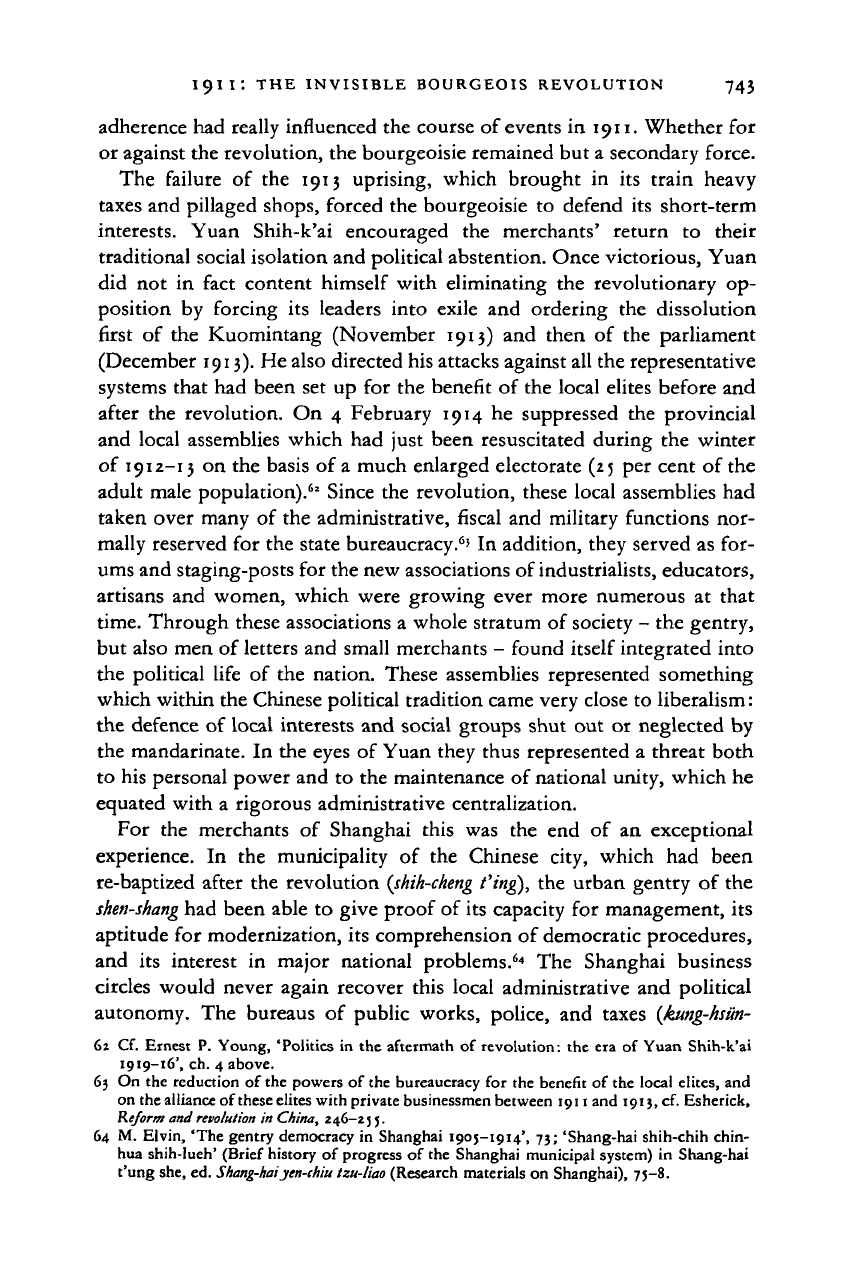
I 9 I I : THE INVISIBLE BOURGEOIS REVOLUTION 743
adherence had really influenced the course of events in 1911. Whether for
or against the revolution, the bourgeoisie remained but a secondary force.
The failure of the 1913 uprising, which brought in its train heavy
taxes and pillaged shops, forced the bourgeoisie to defend its short-term
interests. Yuan Shih-k'ai encouraged the merchants' return to their
traditional social isolation and political abstention. Once victorious, Yuan
did not in fact content himself with eliminating the revolutionary op-
position by forcing its leaders into exile and ordering the dissolution
first of the Kuomintang (November 1913) and then of the parliament
(December 1913). He also directed his attacks against all the representative
systems that had been set up for the benefit of the local elites before and
after the revolution. On 4 February 1914 he suppressed the provincial
and local assemblies which had just been resuscitated during the winter
of 1912-13 on the basis of a much enlarged electorate (25 per cent of the
adult male population).
62
Since the revolution, these local assemblies had
taken over many of the administrative, fiscal and military functions nor-
mally reserved for the state bureaucracy.
6
' In addition, they served as for-
ums and staging-posts for the new associations of industrialists, educators,
artisans and women, which were growing ever more numerous at that
time.
Through these associations a whole stratum of society - the gentry,
but also men of letters and small merchants - found itself integrated into
the political life of the nation. These assemblies represented something
which within the Chinese political tradition came very close to liberalism:
the defence of local interests and social groups shut out or neglected by
the mandarinate. In the eyes of Yuan they thus represented a threat both
to his personal power and to the maintenance of national unity, which he
equated with a rigorous administrative centralization.
For the merchants of Shanghai this was the end of an exceptional
experience. In the municipality of the Chinese city, which had been
re-baptized after the revolution
{shih-cheng
t'ing), the urban gentry of the
shen-shang
had been able to give proof of its capacity for management, its
aptitude for modernization, its comprehension of democratic procedures,
and its interest in major national problems.
6
" The Shanghai business
circles would never again recover this local administrative and political
autonomy. The bureaus of public works, police, and taxes
(kung-hsiin-
62 Cf. Ernest P. Young, 'Politics in the aftermath of revolution: the era of Yuan Shih-k'ai
1919-16', ch. 4 above.
63 On the reduction of the powers of the bureaucracy for the benefit of the local elites, and
on the alliance of these elites with private businessmen between 1911 and
I9i3,cf.
Esherick,
Reform and
revolution
in
China,
246—255.
64 M. Elvin, 'The gentry democracy in Shanghai 1905-1914', 73; 'Shang-hai shih-chih chin-
hua shih-lueh' (Brief history of progress of the Shanghai municipal system) in Shang-hai
t'ung she, ed.
Shang-haiyen-chiu
tzu-liao (Research materials on Shanghai), 75-8.
Cambridge Histories Online © Cambridge University Press, 2008
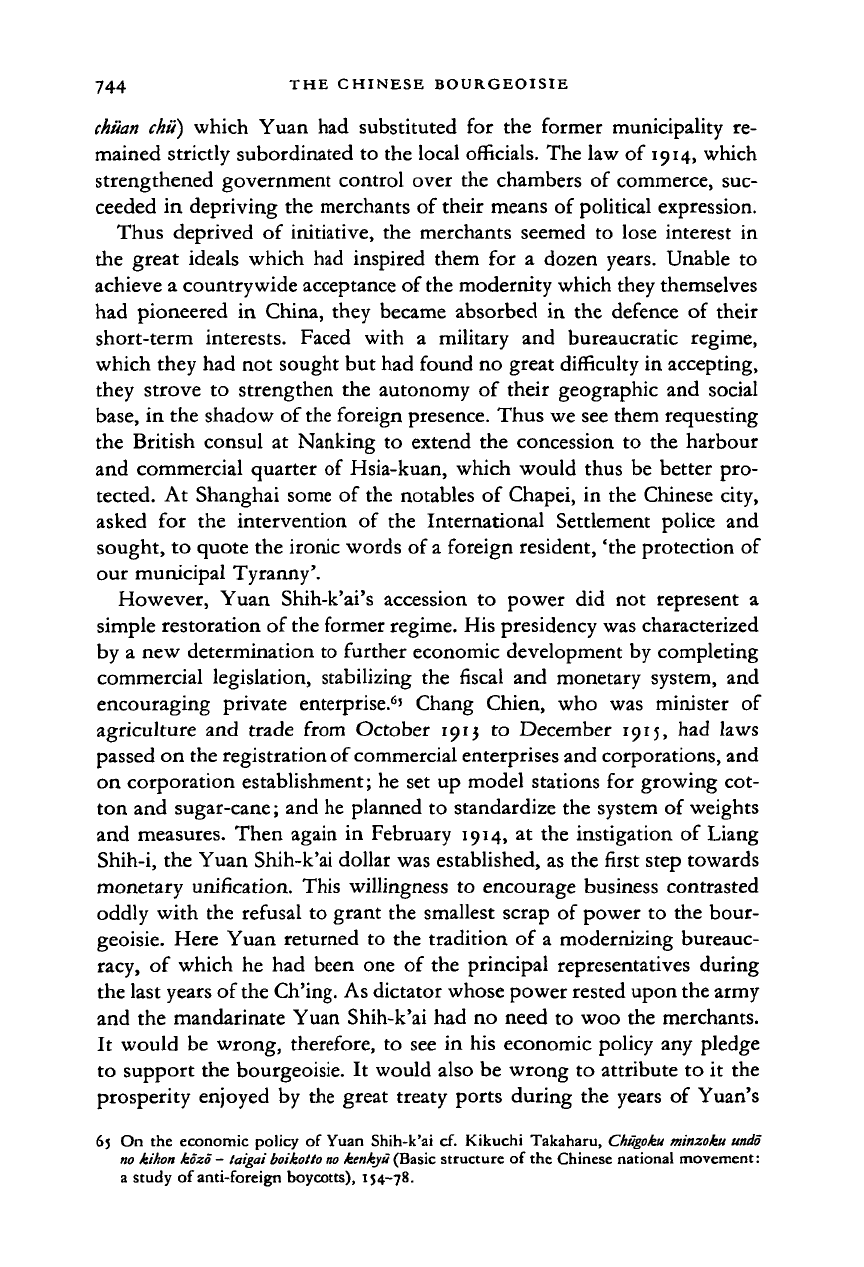
744
THE
CHINESE BOURGEOISIE
chiian
chu) which Yuan
had
substituted
for the
former municipality
re-
mained strictly subordinated
to
the local officials. The law
of
1914, which
strengthened government control over
the
chambers
of
commerce,
suc-
ceeded
in
depriving
the
merchants
of
their means
of
political expression.
Thus deprived
of
initiative,
the
merchants seemed
to
lose interest
in
the great ideals which
had
inspired them
for a
dozen years. Unable
to
achieve
a
countrywide acceptance of the modernity which they themselves
had pioneered
in
China, they became absorbed
in the
defence
of
their
short-term interests. Faced with
a
military
and
bureaucratic regime,
which they had
not
sought but had found
no
great difficulty
in
accepting,
they strove
to
strengthen
the
autonomy
of
their geographic
and
social
base,
in
the shadow
of
the foreign presence. Thus we see them requesting
the British consul
at
Nanking
to
extend
the
concession
to the
harbour
and commercial quarter
of
Hsia-kuan, which would thus
be
better pro-
tected.
At
Shanghai some
of
the notables
of
Chapei,
in the
Chinese city,
asked
for the
intervention
of the
International Settlement police
and
sought,
to
quote the ironic words
of
a foreign resident, 'the protection
of
our municipal Tyranny'.
However, Yuan Shih-k'ai's accession
to
power
did not
represent
a
simple restoration
of
the former regime. His presidency was characterized
by
a
new determination
to
further economic development
by
completing
commercial legislation, stabilizing
the
fiscal
and
monetary system,
and
encouraging private enterprise.
6
' Chang Chien,
who was
minister
of
agriculture
and
trade from October 1913
to
December 1915,
had
laws
passed
on
the registration
of
commercial enterprises and corporations, and
on corporation establishment;
he set up
model stations
for
growing
cot-
ton and sugar-cane; and he planned
to
standardize
the
system
of
weights
and measures. Then again
in
February 1914,
at the
instigation
of
Liang
Shih-i,
the
Yuan Shih-k'ai dollar was established, as the first step towards
monetary unification. This willingness
to
encourage business contrasted
oddly with
the
refusal
to
grant
the
smallest scrap
of
power
to the
bour-
geoisie. Here Yuan returned
to the
tradition
of a
modernizing bureauc-
racy,
of
which
he had
been
one of the
principal representatives during
the last years of the Ch'ing. As dictator whose power rested upon the army
and
the
mandarinate Yuan Shih-k'ai
had no
need
to
woo
the
merchants.
It would
be
wrong, therefore,
to see in his
economic policy
any
pledge
to support
the
bourgeoisie.
It
would also
be
wrong
to
attribute
to it the
prosperity enjoyed
by the
great treaty ports during
the
years
of
Yuan's
65
On the
economic policy
of
Yuan Shih-k'ai
cf.
Kikuchi Takaharu,
Chugoku minzoku undo
no kihon kozo
-
taigai boikotto no kenkyu
(Basic structure
of
the Chinese national movement:
a study
of
anti-foreign boycotts), 154-78.
Cambridge Histories Online © Cambridge University Press, 2008
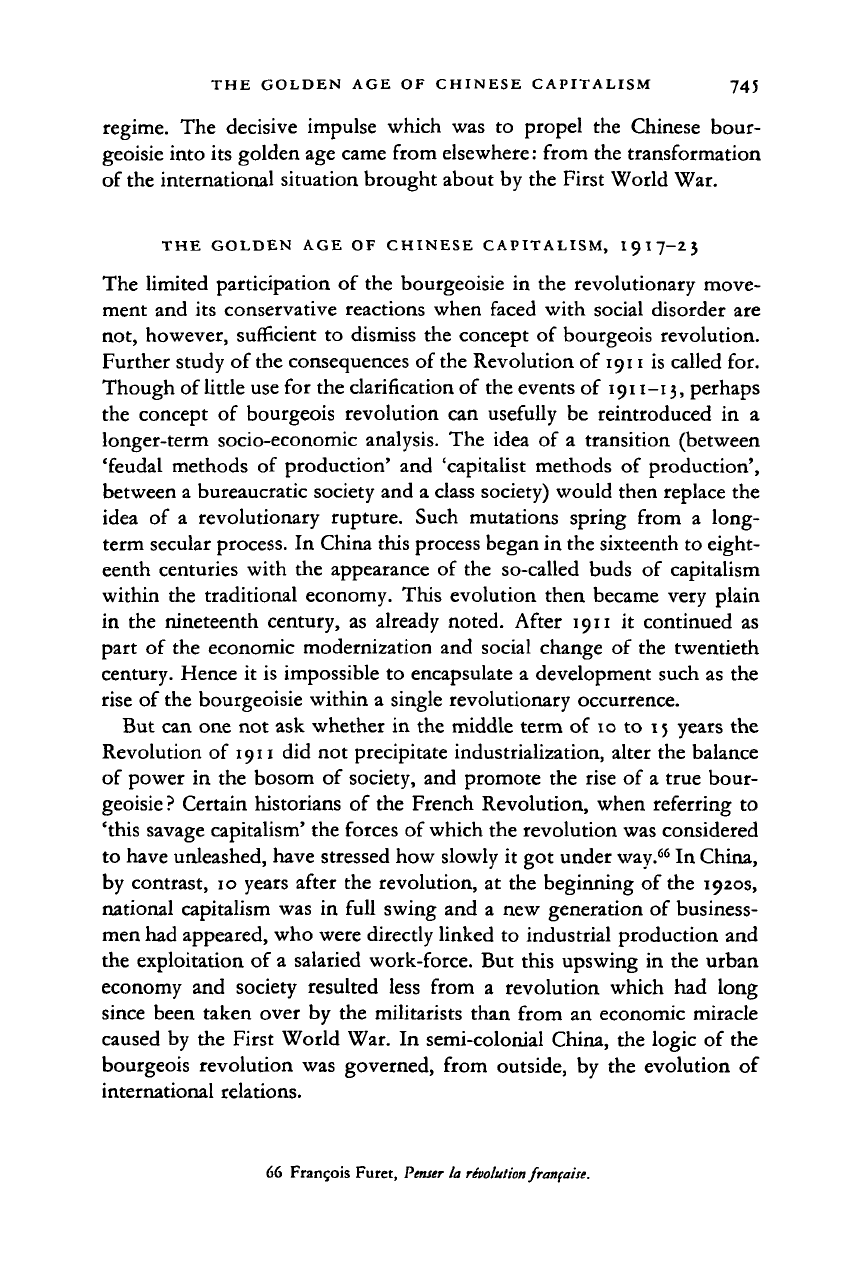
THE GOLDEN AGE OF CHINESE CAPITALISM 745
regime. The decisive impulse which was to propel the Chinese bour-
geoisie into its golden age came from elsewhere: from the transformation
of the international situation brought about by the First World War.
THE GOLDEN AGE OF CHINESE CAPITALISM, I 9 I 7-2 3
The limited participation of the bourgeoisie in the revolutionary move-
ment and its conservative reactions when faced with social disorder are
not, however, sufficient to dismiss the concept of bourgeois revolution.
Further study of the consequences of the Revolution of
1911
is called for.
Though of little use for the clarification of the events of 1911-13, perhaps
the concept of bourgeois revolution can usefully be reintroduced in a
longer-term socio-economic analysis. The idea of a transition (between
'feudal methods of production' and 'capitalist methods of production',
between a bureaucratic society and a class society) would then replace the
idea of a revolutionary rupture. Such mutations spring from a long-
term secular process. In China this process began in the sixteenth to eight-
eenth centuries with the appearance of the so-called buds of capitalism
within the traditional economy. This evolution then became very plain
in the nineteenth century, as already noted. After 1911 it continued as
part of the economic modernization and social change of the twentieth
century. Hence it is impossible to encapsulate a development such as the
rise of the bourgeoisie within a single revolutionary occurrence.
But can one not ask whether in the middle term of 10 to 15 years the
Revolution of 1911 did not precipitate industrialization, alter the balance
of power in the bosom of society, and promote the rise of a true bour-
geoisie
?
Certain historians of the French Revolution, when referring to
'this savage capitalism' the forces of which the revolution was considered
to have unleashed, have stressed how slowly it got under way.
66
In China,
by contrast, 10 years after the revolution, at the beginning of the 1920s,
national capitalism was in full swing and a new generation of business-
men had appeared, who were directly linked to industrial production and
the exploitation of a salaried work-force. But this upswing in the urban
economy and society resulted less from a revolution which had long
since been taken over by the militarists than from an economic miracle
caused by the First World War. In semi-colonial China, the logic of the
bourgeois revolution was governed, from outside, by the evolution of
international relations.
66 Francois Furet,
Penser
la revolution franfaise.
Cambridge Histories Online © Cambridge University Press, 2008
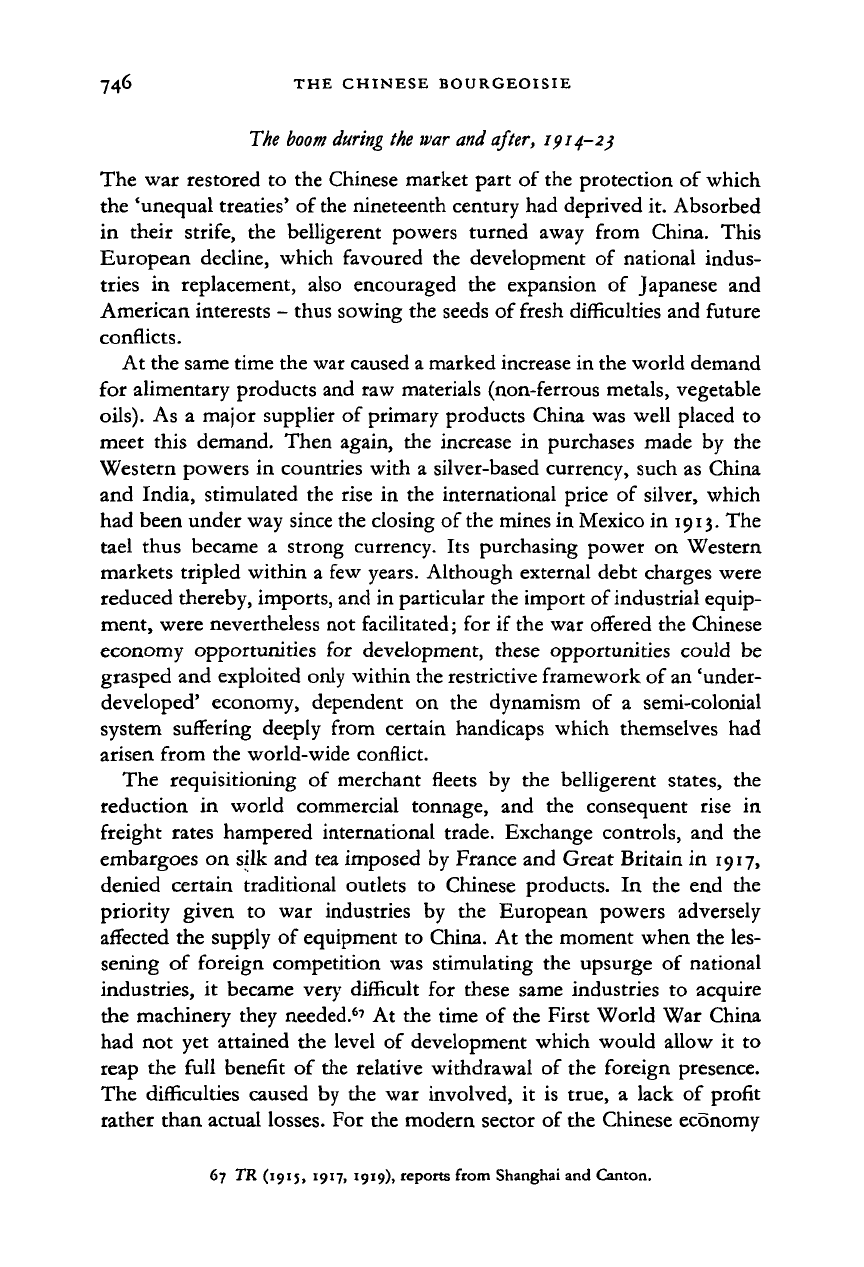
746 THE CHINESE BOURGEOISIE
The
boom
during the war and after, 1914-23
The war restored to the Chinese market part of the protection of which
the 'unequal treaties' of the nineteenth century had deprived it. Absorbed
in their strife, the belligerent powers turned away from China. This
European decline, which favoured the development of national indus-
tries in replacement, also encouraged the expansion of Japanese and
American interests - thus sowing the seeds of fresh difficulties and future
conflicts.
At the same time the war caused a marked increase in the world demand
for alimentary products and raw materials (non-ferrous metals, vegetable
oils).
As a major supplier of primary products China was well placed to
meet this demand. Then again, the increase in purchases made by the
Western powers in countries with a silver-based currency, such as China
and India, stimulated the rise in the international price of silver, which
had been under way since the closing of the mines in Mexico in
1913.
The
tael thus became a strong currency. Its purchasing power on Western
markets tripled within a few years. Although external debt charges were
reduced thereby, imports, and in particular the import of industrial equip-
ment, were nevertheless not facilitated; for if the war offered the Chinese
economy opportunities for development, these opportunities could be
grasped and exploited only within the restrictive framework of an 'under-
developed' economy, dependent on the dynamism of a semi-colonial
system suffering deeply from certain handicaps which themselves had
arisen from the world-wide conflict.
The requisitioning of merchant fleets by the belligerent states, the
reduction in world commercial tonnage, and the consequent rise in
freight rates hampered international trade. Exchange controls, and the
embargoes on silk and tea imposed by France and Great Britain in 1917,
denied certain traditional outlets to Chinese products. In the end the
priority given to war industries by the European powers adversely
affected the supply of equipment to China. At the moment when the les-
sening of foreign competition was stimulating the upsurge of national
industries, it became very difficult for these same industries to acquire
the machinery they needed.
6
' At the time of the First World War China
had not yet attained the level of development which would allow it to
reap the full benefit of the relative withdrawal of the foreign presence.
The difficulties caused by the war involved, it is true, a lack of profit
rather than actual losses. For the modern sector of the Chinese economy
67 TR (1915, 1917, 1919), reports from Shanghai and Canton.
Cambridge Histories Online © Cambridge University Press, 2008
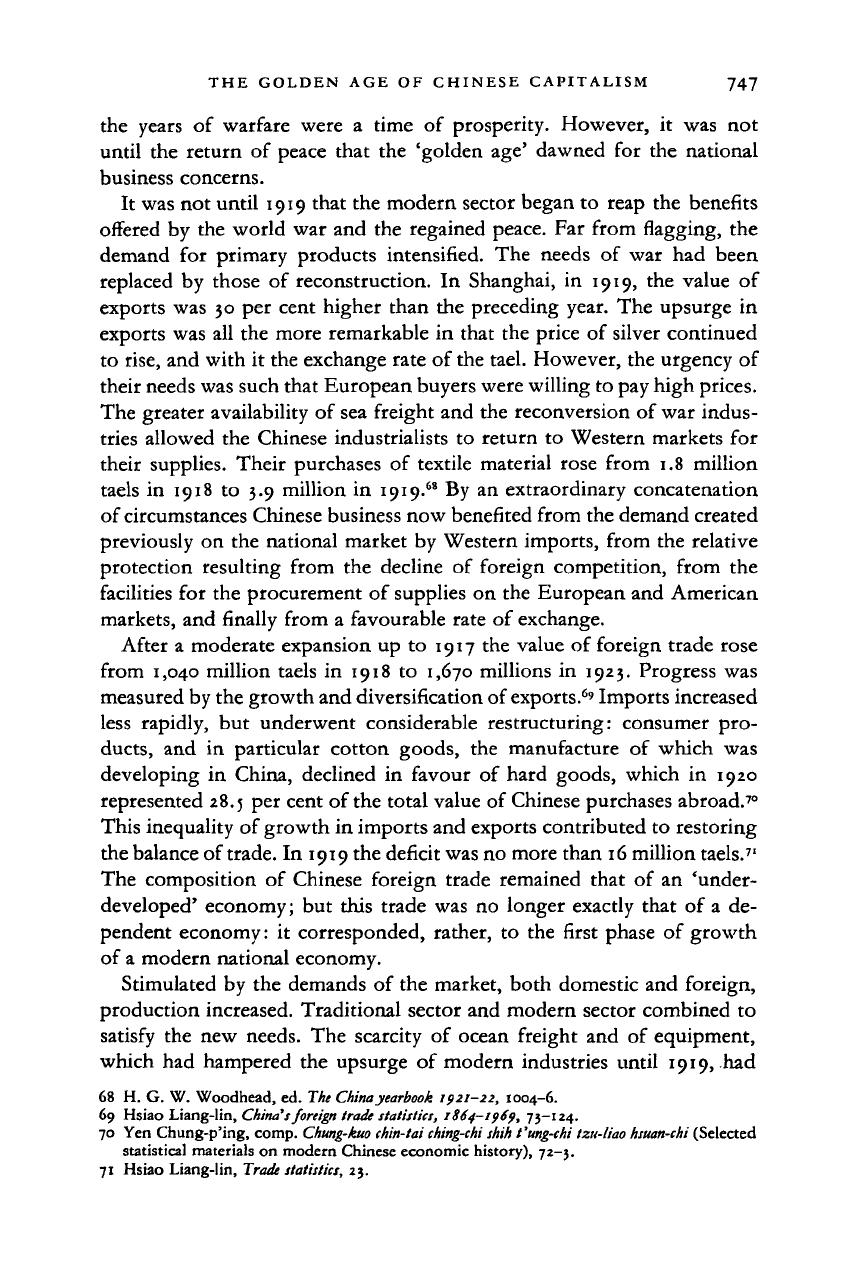
THE GOLDEN AGE OF CHINESE CAPITALISM 747
the years
of
warfare were
a
time
of
prosperity. However,
it
was
not
until
the
return
of
peace that
the
'golden
age'
dawned
for
the
national
business concerns.
It was not until 1919 that the modern sector began
to
reap
the
benefits
offered
by the
world
war and the
regained peace.
Far
from flagging,
the
demand
for
primary products intensified.
The
needs
of
war had
been
replaced
by
those
of
reconstruction.
In
Shanghai,
in
1919,
the
value
of
exports
was 30 per
cent higher than
the
preceding year.
The
upsurge
in
exports was
all the
more remarkable
in
that
the
price
of
silver continued
to rise,
and
with
it
the exchange rate
of
the tael. However, the urgency
of
their needs was such that European buyers were willing to pay high prices.
The greater availability
of
sea freight
and the
reconversion
of
war indus-
tries allowed
the
Chinese industrialists
to
return
to
Western markets
for
their supplies. Their purchases
of
textile material rose from
1.8
million
taels
in
1918
to
3.9
million
in
1919.
68
By an
extraordinary concatenation
of circumstances Chinese business now benefited from the demand created
previously
on the
national market
by
Western imports, from
the
relative
protection resulting from
the
decline
of
foreign competition, from
the
facilities
for the
procurement
of
supplies
on the
European and American
markets,
and
finally from
a
favourable rate
of
exchange.
After
a
moderate expansion
up
to
1917
the
value
of
foreign trade rose
from
1,040
million taels
in
1918
to
1,670
millions
in
1923. Progress
was
measured by the growth and diversification of
exports.
6
'
Imports increased
less rapidly,
but
underwent considerable restructuring: consumer
pro-
ducts,
and in
particular cotton goods,
the
manufacture
of
which
was
developing
in
China, declined
in
favour
of
hard goods, which
in
1920
represented 28.5
per
cent
of
the total value
of
Chinese purchases abroad.
70
This inequality
of
growth in imports and exports contributed
to
restoring
the balance of
trade.
In
1919 the deficit was no more than 16 million taels.
71
The composition
of
Chinese foreign trade remained that
of
an
'under-
developed' economy;
but
this trade
was no
longer exactly that
of
a de-
pendent economy:
it
corresponded, rather,
to
the
first phase
of
growth
of a modern national economy.
Stimulated
by the
demands
of
the market, both domestic
and
foreign,
production increased. Traditional sector
and
modern sector combined
to
satisfy
the new
needs.
The
scarcity
of
ocean freight
and
of
equipment,
which
had
hampered
the
upsurge
of
modern industries until 1919,
had
68
H.
G.
W.
Woodhead,
ed.
The China yearbook 1921-22, 1004-6.
69 Hsiao Liang-lin, China's foreign trade statistics, 1864-1969, 73-124.
70
Yen
Chung-p'ing, comp.
Chung-kuo
chin-tai
ching-chi shih
t'ung-chi tzu-liao
hsuan-chi
(Selected
statistical materials
on
modern Chinese economic history), 72-3.
71 Hsiao Liang-lin,
Trade
statistics,
23.
Cambridge Histories Online © Cambridge University Press, 2008
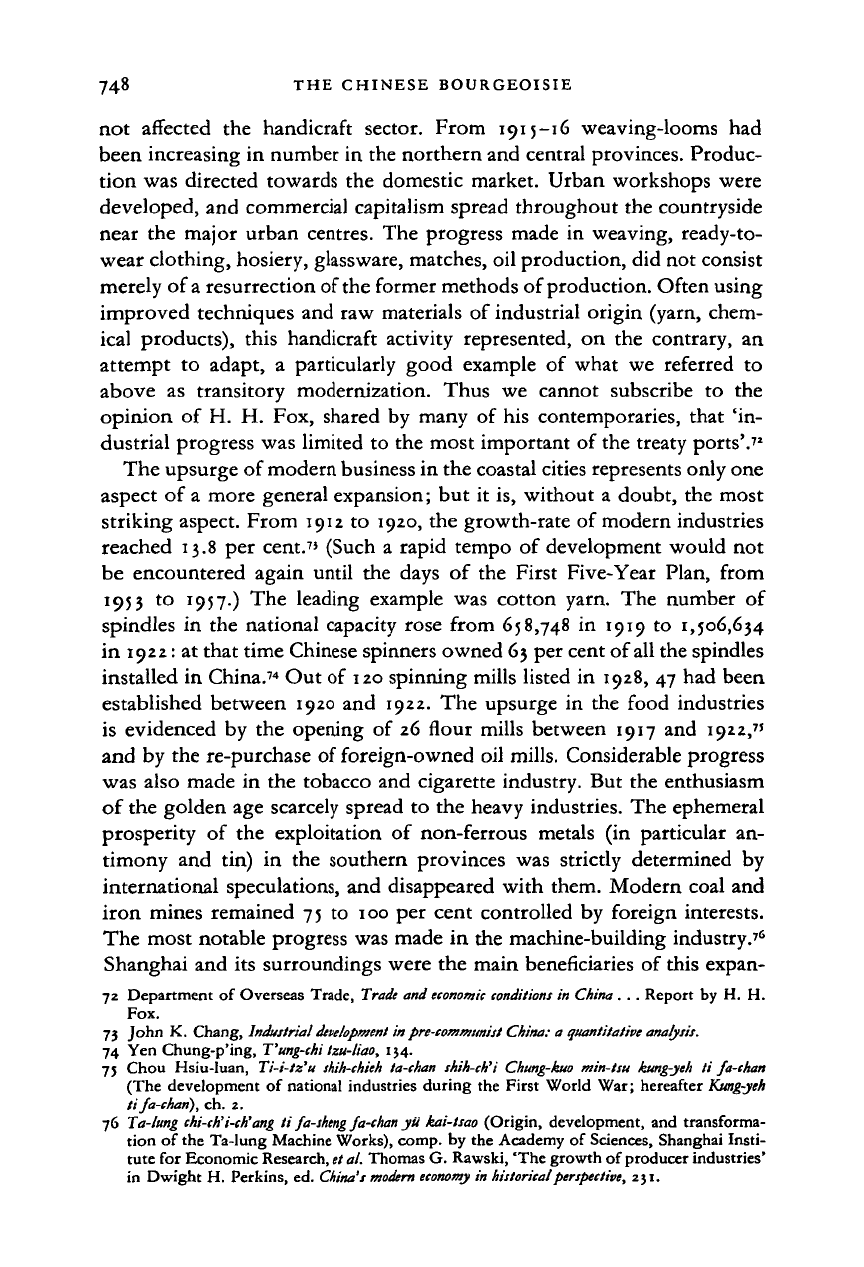
748 THE CHINESE BOURGEOISIE
not affected the handicraft sector. From 1915-16 weaving-looms had
been increasing in number in the northern and central provinces. Produc-
tion was directed towards the domestic market. Urban workshops were
developed, and commercial capitalism spread throughout the countryside
near the major urban centres. The progress made in weaving, ready-to-
wear clothing, hosiery, glassware, matches, oil production, did not consist
merely of a resurrection of the former methods of production. Often using
improved techniques and raw materials of industrial origin (yarn, chem-
ical products), this handicraft activity represented, on the contrary, an
attempt to adapt, a particularly good example of what we referred to
above as transitory modernization. Thus we cannot subscribe to the
opinion of H. H. Fox, shared by many of his contemporaries, that 'in-
dustrial progress was limited to the most important of the treaty ports'.
72
The upsurge of modern business in the coastal cities represents only one
aspect of a more general expansion; but it is, without a doubt, the most
striking aspect. From 1912 to 1920, the growth-rate of modern industries
reached 13.8 per cent.
7
' (Such a rapid tempo of development would not
be encountered again until the days of the First Five-Year Plan, from
1953 to 1957.) The leading example was cotton yarn. The number of
spindles in the national capacity rose from 658,748 in 1919 to
1,506,634
in 1922: at that time Chinese spinners owned 63 per cent of
all
the spindles
installed in China.
74
Out of 120 spinning mills listed in 1928, 47 had been
established between 1920 and 1922. The upsurge in the food industries
is evidenced by the opening of 26 flour mills between 1917 and 1922,
75
and by the re-purchase of foreign-owned oil mills. Considerable progress
was also made in the tobacco and cigarette industry. But the enthusiasm
of the golden age scarcely spread to the heavy industries. The ephemeral
prosperity of the exploitation of non-ferrous metals (in particular an-
timony and tin) in the southern provinces was strictly determined by
international speculations, and disappeared with them. Modern coal and
iron mines remained 75 to 100 per cent controlled by foreign interests.
The most notable progress was made in the machine-building industry.
76
Shanghai and its surroundings were the main beneficiaries of this expan-
72 Department of Overseas Trade, Trade and
economic conditions
in China . . . Report by H. H.
Fox.
73 John K. Chang,
Industrial development in pre-commtmist
China:
a
quantitative
analysis.
74 Yen Chung-p'ing,
T'ung-chi
tzu-liao, 134.
75 Chou Hsiu-Iuan, Ti-i-tz'u
shih-chieh
ta-chan shih-ch'i
Chung-kuo
min-tsu
kung-yeh
ti fa-chan
(The development of national industries during the First World War; hereafter
Kung-yeh
ti
fa-chan),
ch. 2.
76 Ta-lung
chi-ch'i-ch'ang
ti
fa-shtng fa-chan
yti kai-tsao (Origin, development, and transforma-
tion of the Ta-lung Machine Works), comp. by the Academy of Sciences, Shanghai Insti-
tute for Economic Research,
et
al. Thomas G. Rawski, 'The growth of producer industries'
in Dwight H. Perkins, ed.
China's modern economy
in historical perspective, 231.
Cambridge Histories Online © Cambridge University Press, 2008
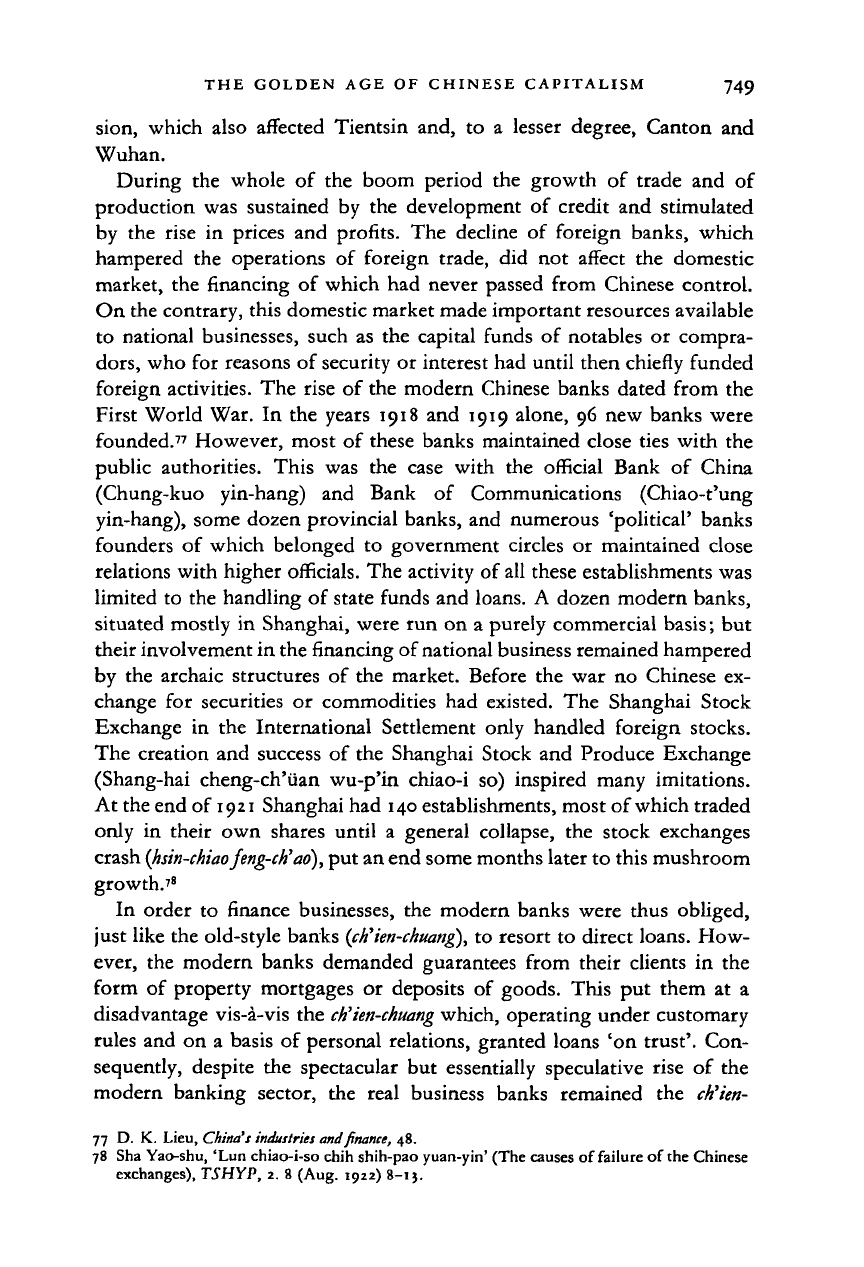
THE GOLDEN AGE OF CHINESE CAPITALISM 749
sion, which also affected Tientsin
and, to a
lesser degree, Canton
and
Wuhan.
During
the
whole
of the
boom period
the
growth
of
trade
and of
production
was
sustained
by the
development
of
credit
and
stimulated
by
the
rise
in
prices
and
profits.
The
decline
of
foreign banks, which
hampered
the
operations
of
foreign trade,
did not
affect
the
domestic
market,
the
financing
of
which
had
never passed from Chinese control.
On the contrary, this domestic market made important resources available
to national businesses, such
as the
capital funds
of
notables
or
compra-
dors,
who
for
reasons
of
security
or
interest had until then chiefly funded
foreign activities.
The
rise
of
the modern Chinese banks dated from
the
First World War.
In the
years 1918
and
1919 alone,
96 new
banks were
founded.
77
However, most
of
these banks maintained close ties with
the
public authorities. This
was the
case with
the
official Bank
of
China
(Chung-kuo yin-hang)
and
Bank
of
Communications (Chiao-t'ung
yin-hang), some do2en provincial banks,
and
numerous 'political' banks
founders
of
which belonged
to
government circles
or
maintained close
relations with higher officials. The activity
of
all these establishments was
limited
to the
handling
of
state funds
and
loans.
A
dozen modern banks,
situated mostly
in
Shanghai, were
run on a
purely commercial basis;
but
their involvement in the financing of national business remained hampered
by
the
archaic structures
of the
market. Before
the war no
Chinese
ex-
change
for
securities
or
commodities
had
existed.
The
Shanghai Stock
Exchange
in the
International Settlement only handled foreign stocks.
The creation
and
success
of
the Shanghai Stock
and
Produce Exchange
(Shang-hai cheng-ch'iian wu-p'in chiao-i
so)
inspired many imitations.
At the end
of
1921
Shanghai had 140 establishments, most
of
which traded
only
in
their
own
shares until
a
general collapse,
the
stock exchanges
crash (hsin-chiao feng-cW
ao),
put an end some months later to this mushroom
growth.
7
'
In order
to
finance businesses,
the
modern banks were thus obliged,
just like
the
old-style banks
(ch'ien-chuang),
to
resort
to
direct loans. How-
ever,
the
modern banks demanded guarantees from their clients
in the
form
of
property mortgages
or
deposits
of
goods. This
put
them
at a
disadvantage vis-a-vis
the
ch'ien-chuang
which, operating under customary
rules
and on a
basis
of
personal relations, granted loans
'on
trust'.
Con-
sequently, despite
the
spectacular
but
essentially speculative rise
of the
modern banking sector,
the
real business banks remained
the
ch'ien-
77
D. K.
Lieu,
China's industries
and
finance,
48.
78 Sha Yao-shu, 'Lun chiao-i-so chih shih-pao yuan-yin' (The causes
of
failure
of
the Chinese
exchanges), TSHYP,
2. 8
(Aug. 1922)
8-IJ.
Cambridge Histories Online © Cambridge University Press, 2008
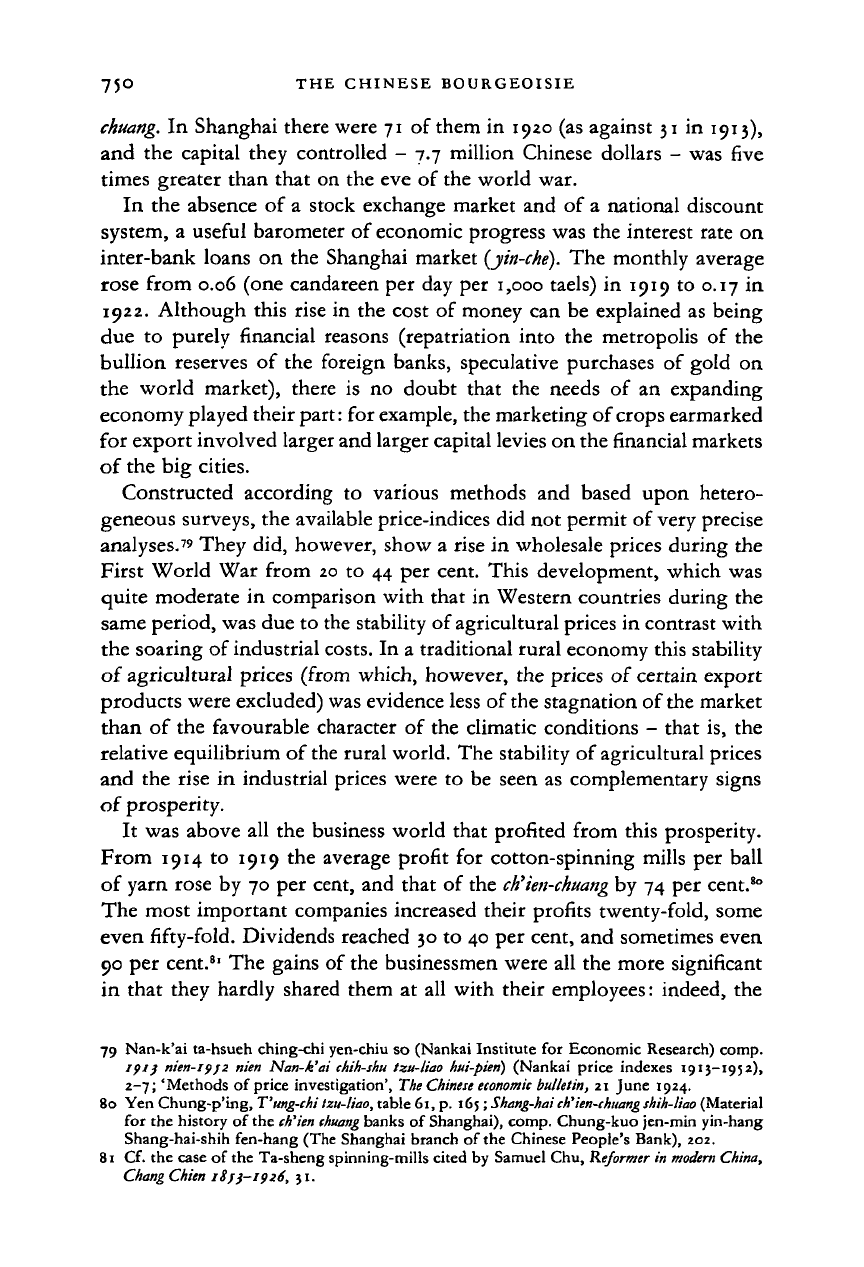
7JO THE CHINESE BOURGEOISIE
chuang.
In
Shanghai there were 71
of
them
in
1920 (as against 31
in
1913),
and
the
capital they controlled
- 7.7
million Chinese dollars
- was
five
times greater than that
on the eve of
the world
war.
In
the
absence
of a
stock exchange market
and of a
national discount
system,
a
useful barometer
of
economic progress was
the
interest rate
on
inter-bank loans
on the
Shanghai market
(yin-c/ie).
The
monthly average
rose from 0.06 (one candareen
per
day
per 1,000
taels)
in
1919
to
0.17
in
1922.
Although this rise
in the
cost
of
money
can be
explained
as
being
due
to
purely financial reasons (repatriation into
the
metropolis
of the
bullion reserves
of the
foreign banks, speculative purchases
of
gold
on
the world market), there
is no
doubt that
the
needs
of an
expanding
economy played their part: for example, the marketing of crops earmarked
for export involved larger and larger capital levies on the financial markets
of the
big
cities.
Constructed according
to
various methods
and
based upon hetero-
geneous surveys, the available price-indices did
not
permit
of
very precise
analyses.
79
They did, however, show
a
rise
in
wholesale prices during
the
First World
War
from
20 to 44 per
cent. This development, which
was
quite moderate
in
comparison with that
in
Western countries during
the
same period, was due
to
the stability
of
agricultural prices
in
contrast with
the soaring
of
industrial costs.
In a
traditional rural economy this stability
of agricultural prices (from which, however,
the
prices
of
certain export
products were excluded) was evidence less
of
the stagnation
of
the market
than
of
the favourable character
of
the climatic conditions
-
that
is, the
relative equilibrium
of
the rural world. The stability
of
agricultural prices
and
the
rise
in
industrial prices were
to be
seen
as
complementary signs
of prosperity.
It
was
above
all the
business world that profited from this prosperity.
From 1914
to
1919
the
average profit
for
cotton-spinning mills
per
ball
of yarn rose
by 70 per
cent,
and
that
of
the
ch
y
ien-chuang
by 74 per
cent.
80
The most important companies increased their profits twenty-fold, some
even fifty-fold. Dividends reached 30
to
40
per
cent,
and
sometimes even
90
per
cent.
8
'
The
gains
of
the businessmen were
all the
more significant
in that they hardly shared them
at all
with their employees: indeed,
the
79 Nan-k'ai ta-hsueh ching-chi yen-chiu
so
(Nankai Institute
for
Economic Research) comp.
ifi) nien-if/2 men Nan-k'ai
chih-shu tzu-liao hui-pieri)
(Nankai price indexes 1913-1952),
2-7;
'Methods
of
price investigation', The
Chinese economic
bulletin,
21
June
1924.
80 Yen Chung-p'ing, Tung-chi
tzu-liao,
table
6i, p.
165;
Shang-haicKien-chuangshih-liao
(Material
for the history
of
the
ch'ien chuang
banks
of
Shanghai), comp. Chung-kuo jen-min yin-hang
Shang-hai-shih fen-hang (The Shanghai branch
of
the Chinese People's Bank), 202.
81
Cf.
the case
of
the Ta-sheng spinning-mills cited by Samuel Chu,
Reformer in modem
China,
Chang Chien
i8j}-i9i6, 31.
Cambridge Histories Online © Cambridge University Press, 2008
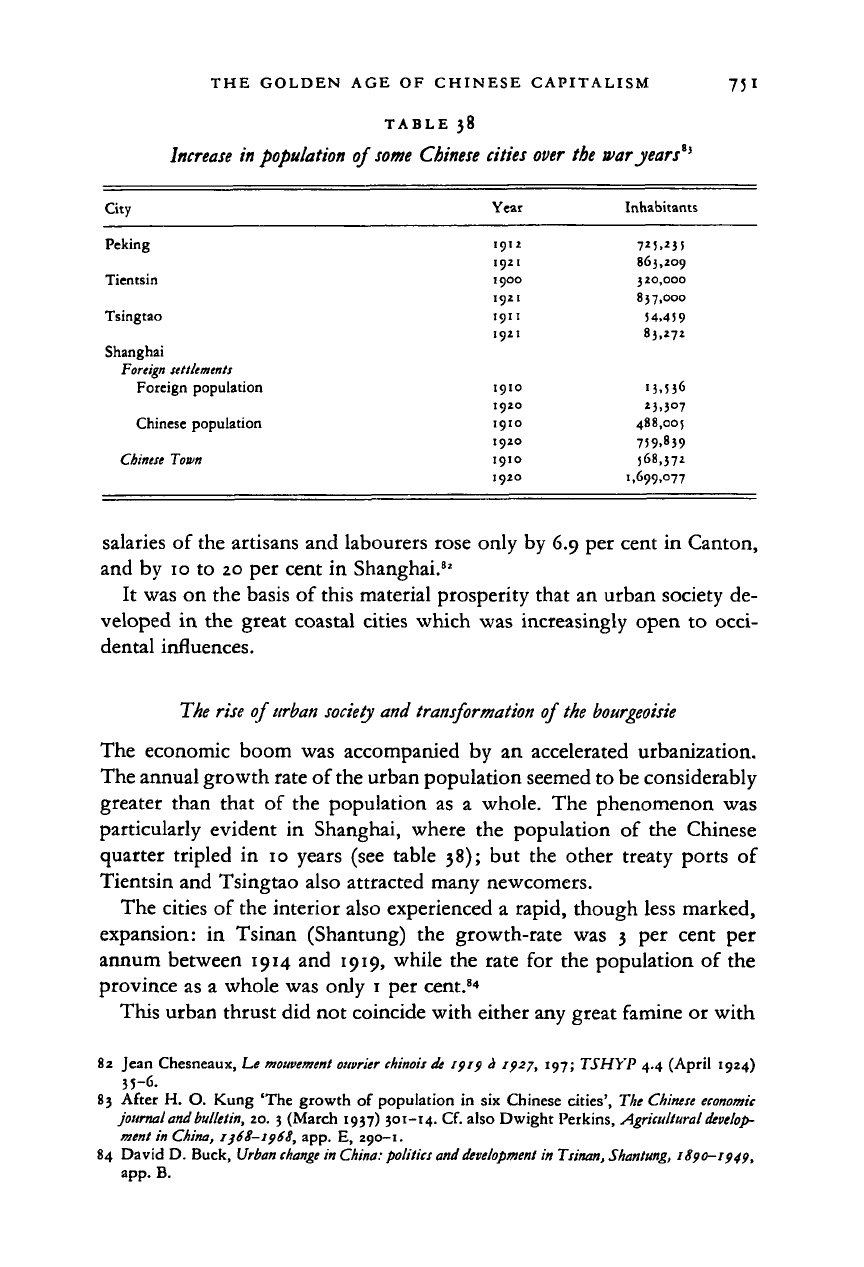
THE GOLDEN AGE OF CHINESE CAPITALISM 75 I
TABLE 38
1912
1921
1900
1921
1911
1921
1910
1920
1910
1920
1910
1920
7*5.235
863,209
320,000
837,000
54.459
83.*7*
'3.536
*3.3°7
488,00;
759.839
568,572
1,699,077
Increase
in population
of
some Chinese
cities
over
the
war years
1
*
City Year Inhabitants
Peking
Tientsin
Tsingtao
Shanghai
Foreign settlements
Foreign population
Chinese population
Chinese Town
salaries
of
the artisans
and
labourers rose only
by 6.9 per
cent
in
Canton,
and
by 10 to 20 per
cent
in
Shanghai.
82
It
was on the
basis
of
this material prosperity that
an
urban society
de-
veloped
in the
great coastal cities which
was
increasingly open
to
occi-
dental influences.
The rise
of
urban society
and
transformation
of
the
bourgeoisie
The economic boom
was
accompanied
by an
accelerated urbani2ation.
The annual growth rate of the urban population seemed
to
be considerably
greater than that
of the
population
as a
whole.
The
phenomenon
was
particularly evident
in
Shanghai, where
the
population
of the
Chinese
quarter tripled
in 10
years
(see
table
38); but the
other treaty ports
of
Tientsin
and
Tsingtao also attracted many newcomers.
The cities
of
the interior also experienced
a
rapid, though less marked,
expansion:
in
Tsinan (Shantung)
the
growth-rate
was 3 per
cent
per
annum between 1914
and
1919, while
the
rate
for the
population
of the
province
as a
whole was only
1
per
cent.
84
This urban thrust
did not
coincide with either any great famine
or
with
82 Jean Chesneaux,
Le
mouvement ouvrier chinois
de rfif
a 1927, 197;
TSHYP
4.4
(April
1924)
35-6.
83 After
H. O.
Kung
'The
growth
of
population
in six
Chinese cities', The
Chinese economic
journal and
bulletin,
20. 3 (March 1937) 301-14.
Cf.
also Dwight Perkins, Agricultural
develop-
ment
in
China, 1)68—1968, app.
E,
290-1.
84 David
D.
Buck,
Urban change
in
China:
politics and
development
in
Tsinan, Shantung,
app.
B.
Cambridge Histories Online © Cambridge University Press, 2008
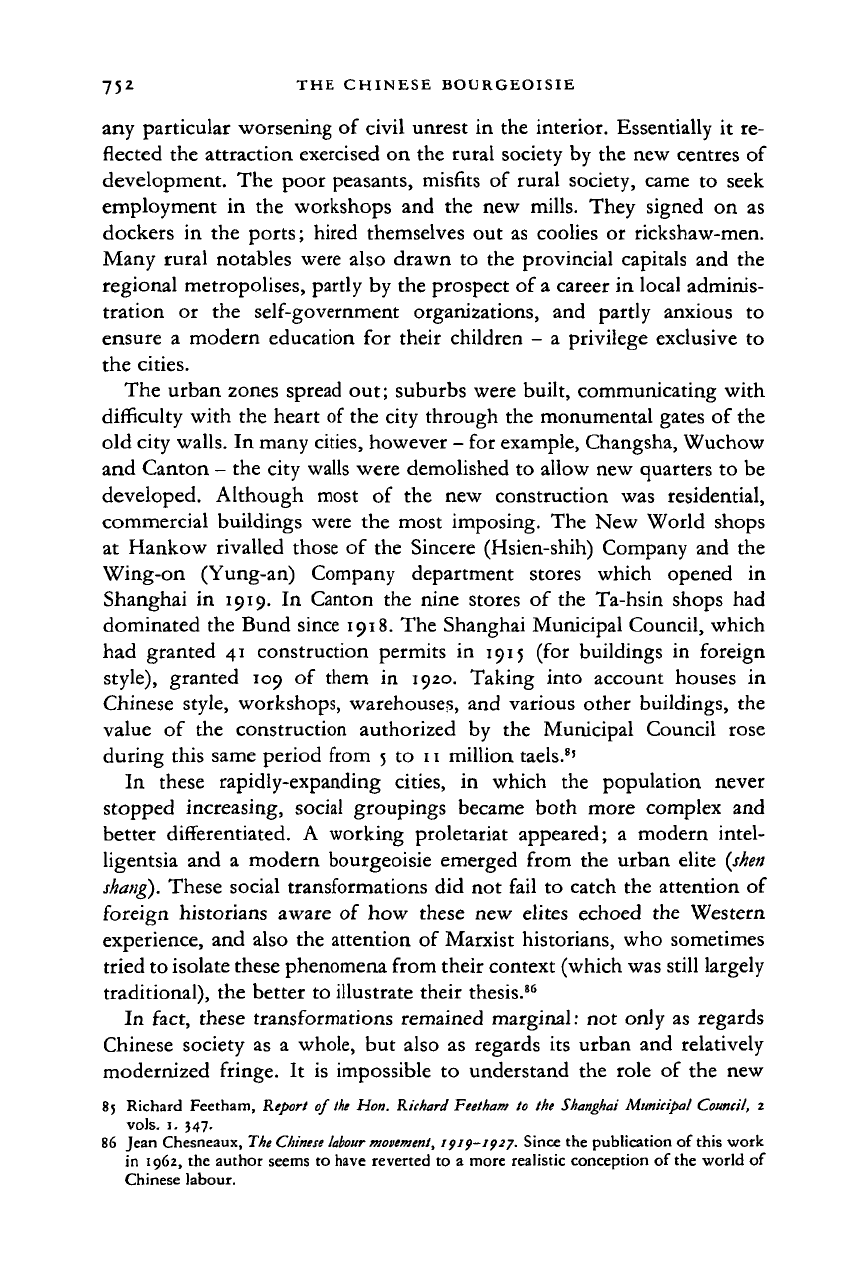
75*
THE CHINESE BOURGEOISIE
any particular worsening
of
civil unrest
in
the interior. Essentially
it
re-
flected the attraction exercised on the rural society by the new centres of
development. The poor peasants, misfits
of
rural society, came
to
seek
employment
in the
workshops and
the
new mills. They signed
on as
dockers
in
the ports; hired themselves out as coolies
or
rickshaw-men.
Many rural notables were also drawn
to
the provincial capitals and the
regional metropolises, partly by the prospect of a career in local adminis-
tration
or the
self-government organizations,
and
partly anxious
to
ensure
a
modern education
for
their children
- a
privilege exclusive
to
the cities.
The urban 2ones spread out; suburbs were built, communicating with
difficulty with the heart of the city through the monumental gates of the
old city walls. In many cities, however
-
for example, Changsha, Wuchow
and Canton
-
the city walls were demolished to allow new quarters to be
developed. Although most
of the new
construction
was
residential,
commercial buildings were the most imposing. The New World shops
at Hankow rivalled those
of
the Sincere (Hsien-shih) Company and the
Wing-on (Yung-an) Company department stores which opened
in
Shanghai
in
1919.
In
Canton the nine stores
of
the Ta-hsin shops had
dominated the Bund since 1918. The Shanghai Municipal Council, which
had granted 41 construction permits
in
1915
(for
buildings
in
foreign
style),
granted
109 of
them
in
1920. Taking into account houses
in
Chinese style, workshops, warehouses, and various other buildings,
the
value
of the
construction authorized
by the
Municipal Council rose
during this same period from 5
to
11 million taels.
8
'
In these rapidly-expanding cities,
in
which
the
population never
stopped increasing, social groupings became both more complex
and
better differentiated.
A
working proletariat appeared;
a
modern intel-
ligentsia and
a
modern bourgeoisie emerged from the urban elite
(shen
shang).
These social transformations did not fail
to
catch the attention of
foreign historians aware
of
how these new elites echoed
the
Western
experience, and also the attention
of
Marxist historians, who sometimes
tried to isolate these phenomena from their context (which was still largely
traditional), the better to illustrate their thesis.
86
In fact, these transformations remained marginal: not only as regards
Chinese society
as a
whole, but also
as
regards
its
urban and relatively
modernized fringe.
It is
impossible
to
understand the role
of
the new
85
Richard Feetham, Report
of
the
Hon. Richard Feetham
to
the Shanghai Municipal Council,
z
vols.
1.
347.
86 Jean Chesneaux, The
Chinese labour
movement,
1919-1927. Since the publication of this work
in 1962, the author seems
to
have reverted
to a
more realistic conception
of
the world of
Chinese labour.
Cambridge Histories Online © Cambridge University Press, 2008
